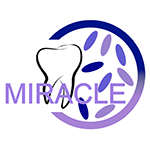Link to the latest publication
MIRACLE aimed to develop new strategies for risk identification and progression control of dental caries by leveraging insights into the healthy oral microbiome. Our research team collaborated with leading companies in oral healthcare and imaging, including DENTAID and Inspector Research Systems BV.
Dental caries is a major global public health issue, affecting over 80% of children worldwide. In the Netherlands alone, childhood dental problems result in an annual socioeconomic burden exceeding €437 million in healthcare costs. Preventing a single caries lesion during childhood can save approximately €1,800 over a patient’s lifetime—especially significant for individuals from lower socioeconomic backgrounds, who are disproportionately affected. Traditional intervention strategies focusing on risk factors such as sugar consumption and oral hygiene have not been universally successful in stopping the disease. Recent studies suggest that unfavorable changes in the oral microbiome may play a key role in its development.
By combining an exceptionally large dataset with state-of-the-art technological innovations, we aimed to deepen our understanding of the composition and function of the oral microbiome in both health and disease. We anticipate that insights into the characteristics of a healthy oral microbiome will serve as a foundation for the future development of specialized oral healthcare products, ultimately leading to improved and sustainable oral health in the general population.
At the conclusion of the project, we had assembled the largest dataset to date on the oral microbiome of adolescents (n = 4,842) and gained essential expertise in analyzing large-scale data. We disseminated our findings through scientific publications and presentations, detailing the composition of the oral microbiome in healthy, caries-free children. Additionally, we identified several factors that may influence the oral microbiome’s composition, including lung function, orthodontic treatment, oral hygiene habits, and puberty.
These insights bring us closer to identifying new targets for preventive dental care. Our results have been published in scientific journals, with additional findings set to be released soon. Since oral health and overall health are closely interconnected, investing in oral care is crucial for enhancing both individual well-being and public health.

